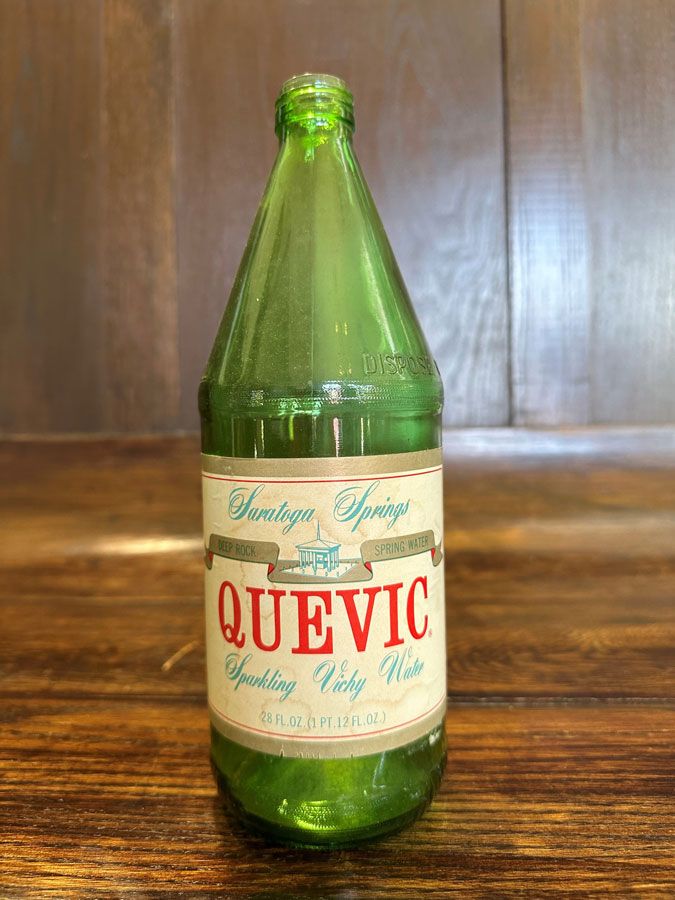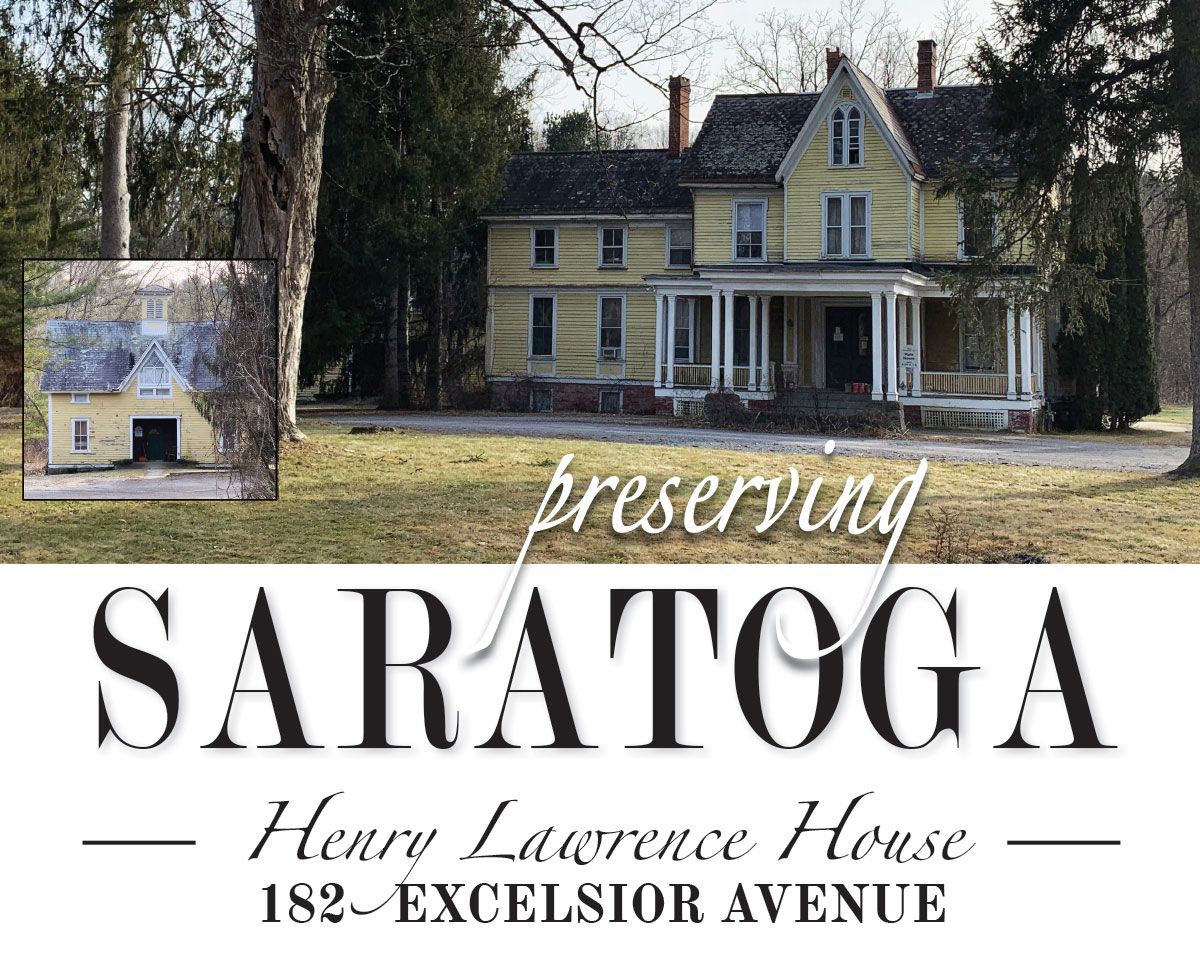
WRITTEN by Samantha Bosshart, Saratoga Springs Preservation Foundation
Photos provided by Saratoga Springs Preservation Foundation (unless Noted)
It is an eclectic mix of buildings – municipal, commercial, mixed-used, and residential – as one drives east on Excelsior Avenue from Marion Avenue. Set back from the street at the corner of Excelsior Spring Avenue is a yellow house. Sometimes it catches your eye as you drive by and other times it does not. I have long admired it for its Gothic Revival architecture – its steeply pitched center gable, decoratively patterned slate roof, and Gothic arched windows. It stands as a reminder of a different time.
The land on which it sits was known as the Valley of the Ten Springs, named for a group of springs that pioneer merchants John and Ziba Taylor discovered on their land in 1814. Within several years, the Taylor brothers built the Mansion House, a seasonal boarding house. In 1829, Henry Haydock Lawrence (1791-1861), a New York City merchant, acquired the Valley of the Ten Springs property.
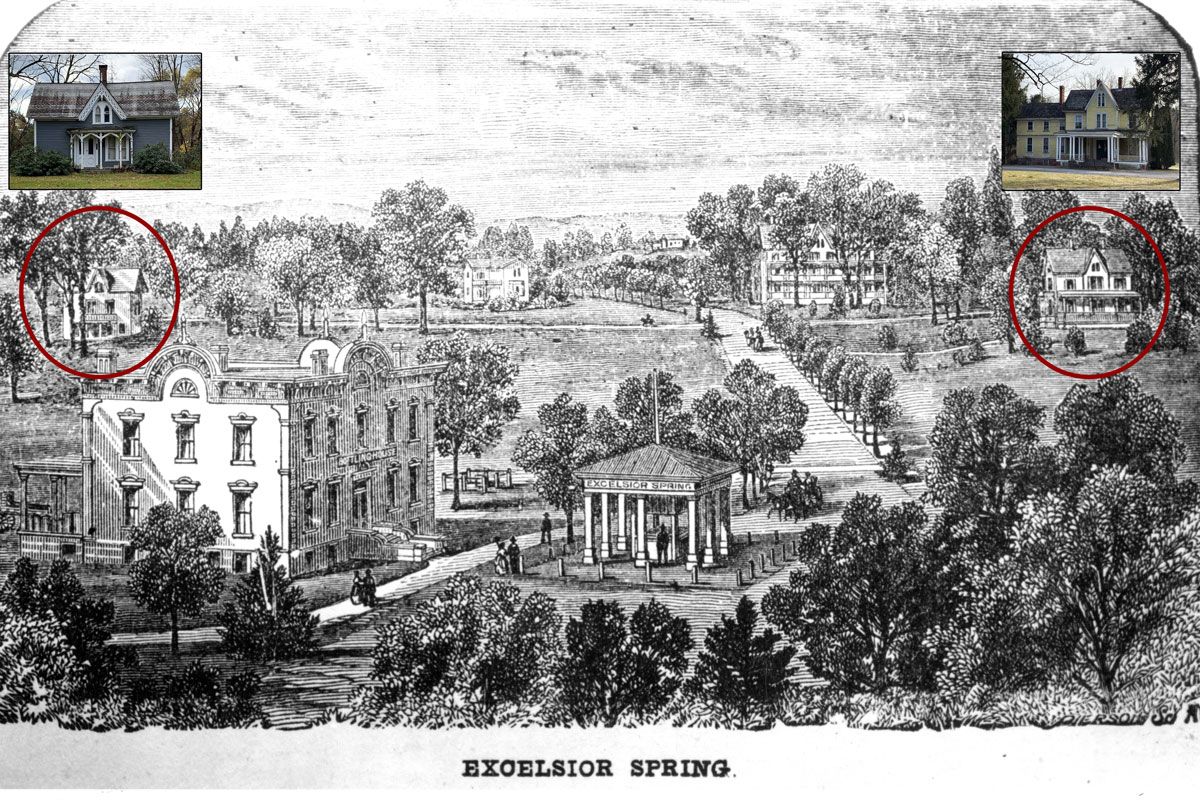
An illustration from the 1873 multi-page Excelsior Park brochure showing the rear of the 1869 Henry Lawrence House at the top right corner and the Smiley-Brackett Cottage at the top left corner with the Excelsior Spring pavilion in the foreground.
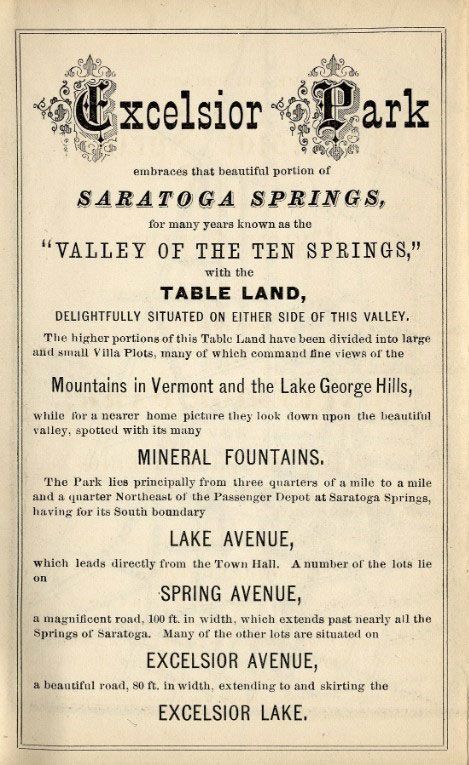
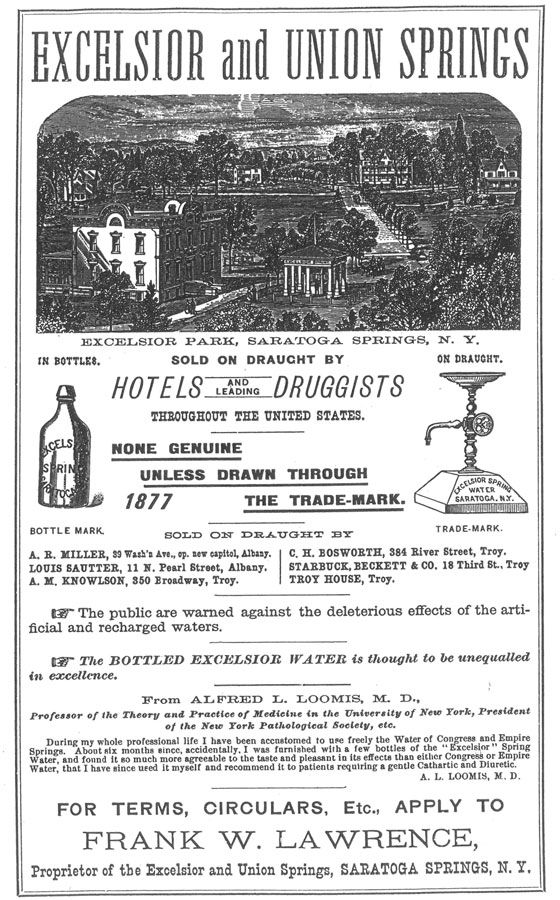
(left) A description of the property from the multi-page 1873 Excelsior Park brochure.
(right) An Advertisement for Excelsior and Union Springs.
By 1858, Lawrence’s son, Henry Lawrence (1832-1882) had retubed and bottled the waters from Excelsior Spring and was selling them worldwide. He was credited with using hydrostatic pressure to pump water from a depth of 56 feet without compromising the quality of the water. In 1865, Henry retubed the waters from the Union Spring and sold it in bottles and 30-gallon barrels. The following year, A.R. Lawrence, Henry’s cousin and business partner, received a U.S. Patent for his “Soda-Water Apparatus,” which added a small amount of tartaric acid to the mineral waters to prevent sediments from forming.
Impressed with the success of John Clarke’s development of Congress Park — which included springs, a pavilion, walking paths, and lots for development — Henry created Excelsior Park in 1868. He laid out 100 building lots along Excelsior Spring Avenue, from Lake Avenue to the eastern shore of Excelsior Lake, today known as Loughberry Lake. Excelsior Park was described as “Saratoga’s most conscious attempt at a garden suburb.” It included a tree-lined walk through the Valley of the Ten Springs to his pavilion, a bottling plant, the Mansion House, and building lots.
In 1869, Henry constructed his large private residence on the corner, near his spring pavilion, bottling plant, and Mansion House. He and his wife, Caroline, raised their children – Marion, Frank, Caroline, Henry, and Alice – there.
However, only a few of the building lots were developed. In 1872, Sarah F. Smiley acquired a lot and built a small cottage at 166 Excelsior Avenue in the same Gothic Revival style as Henry Lawrence’s house. The house that Smiley constructed and later owned by screenwriter Charles Brackett was designated a City Landmark in 2021.
It is during this same time that the Village of Saratoga Springs needed to secure a pure water supply. On February 28, 1870, a 15-member commission was created to obtain a water supply for sanitary purposes and the fire department for the fast-growing village. In July, Henry and A.R. offered Excelsior Lake to be the source of the water supply as well as land to construct water works for the sum of $20,000. The commission unanimously voted to accept the proposition, purchasing 7.5 acres for $22,775. By August, the commission was under contract with Holly Company of Lockport to install the required machinery for the new village water works at a cost of $35,000. It was reported that the estimated total cost of the waterworks would be $80,000, equivalent to $1.9 million today.
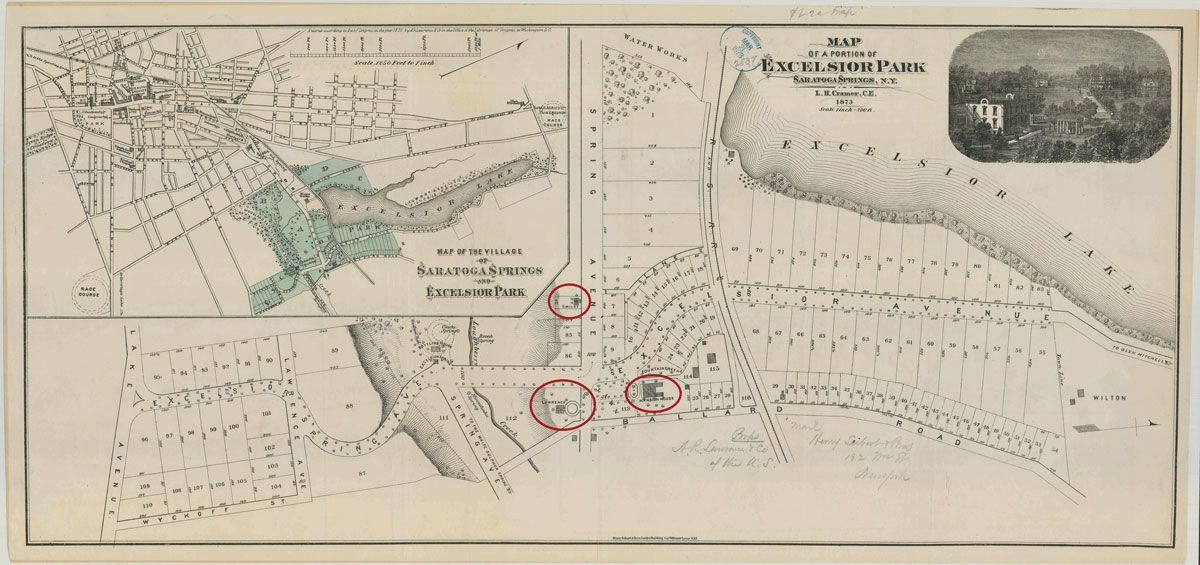
The fold-out map from the multi-page 1873 Excelsior Park brochure, showing the location of the building lots, Excelsior Lake (now Loughberry Lake), the 1869 Henry Lawrence Residence (bottome left), The Mansion House (bottom right), and Smiley-Brackett House (top).

A portion of an 1895 Map of Saratoga Springs and Excelsior Park showing the lake renamed to Loughberry Lake (below a photo today), the location the Lawrence Residence and the location of the water works, inset with a picture of the building. (George S. Bolster Collection, Saratoga Springs History Museum).
An 1873 Excelsior Park multi-page brochure with a fold-out map described it as “delightfully situated on either side of the valley” and the “highest portions of this Table Land have been divided into large and small Villa Plots, many of which command views of the Mountains in Vermont and the Lake George Hills.” It also describes various springs – Excelsior, Union, Minnehaha, and White Sulphur; the “magnificent woods” with its wide and shady paths; and the Mansion House, where “many of the most refined and wealthy families of our great cities spend the Summer Months.” Excelsior Lake is also highlighted in the brochure. “Excelsior Lake, a beautiful sheet of water, one mile in length, also adds charms to this very desirable property.” The lake is “fed by trout streams of sparkling clearness” and “here are situated the Loughberry Water Works, made doubly interesting by their picturesque surroundings and by the famous Holly Machinery, by which water is raised.”
Sadly, Henry Lawrence died at the young age of 49 when he drowned in Lake George. The Saratoga Sentinel obituary dated August 10, 1882, states that he “devoted himself to the improvement and development of the Ten Springs property … Henry, after much labor and investigation, managed to find a way of shipping mineral water in tin-lined barrels, in which he soon secured a large trade … Besides working for his own benefit, in improving the Ten Springs property, Mr. Lawrence has shown a public spirit in looking after the affairs of the community ... His death is a loss to the whole community.”
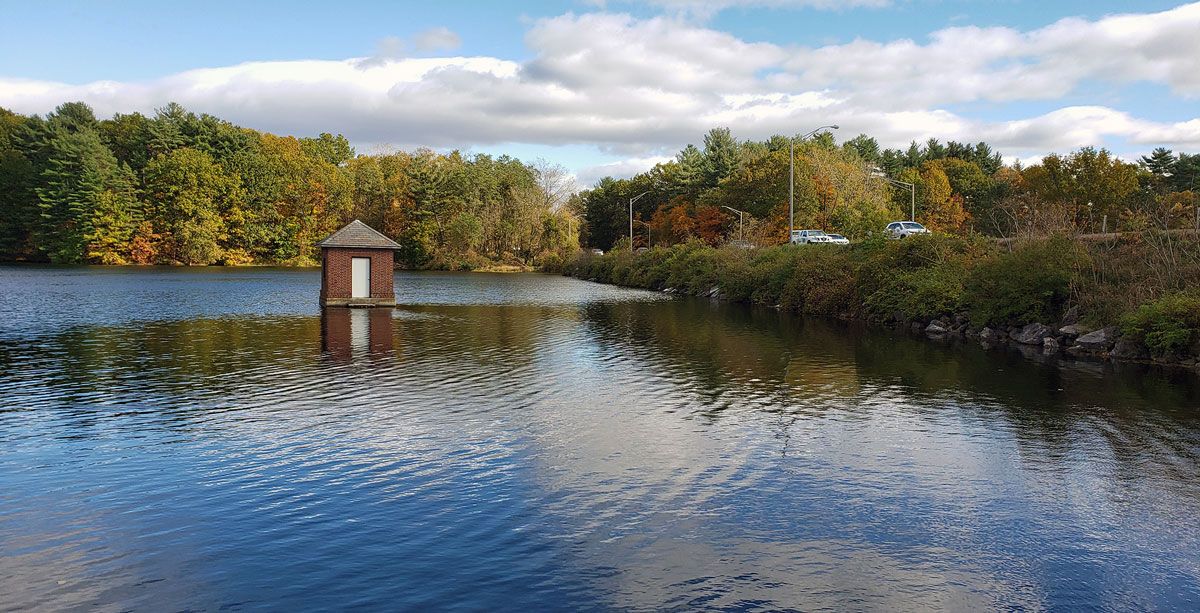
Loughberry Lake (Schnabel Engineering)
Following Henry’s passing, Caroline, his wife, continued to own and reside at 182 Excelsior Avenue and was periodically listed in the city directories as the proprietor of Excelsior and Union springs. Active in the community, Caroline helped to organize the Saratoga Union Mission and served as president of the Women’s Christian Temperance Union, president of the Bible Reader’s Society, and vice president of the Saratoga Humane Society, which sought the protection of children and animals.
On May 17, 1888, acting as executrix and trustee of Henry’s estate, Caroline sold her husband’s extensive real estate holdings to their son Frank W. Lawrence. Throughout the years Frank as well as other family members managed different aspects of Excelsior Park – Excelsior and Union springs, Mansion House, and Excelsior Spring Park Cottage. Prior to 1900, Frank W. Lawrence drilled the Quevic Spring, located near Excelsior Spring, and named it after Queen Victoria, whom he admired. It was advertised as the “Queen of Spring Waters.” Frank passed away in 1939. Following his death, his daughter Emily Lawrence Smith operated Quevic Company for 11 years. In 1951, she sold Quevic Spring to Carl E. Touhey.
The property at 182 Excelsior Avenue remained in the Lawrence family until the great granddaughter of Henry Haydock Lawrence, Emily Lawrence Smith, sold it to Stanley and Elsie Bogan in 1948. Since that time the property has had a series of owners and was made into a rooming house/apartments.
The current owner has listed the property for sale, and it is currently under contract. Initial plans by the developer proposed to remove all the historic structures from the lot and construct three buildings with 36 apartments. After learning the significance of the property, the developer has amended the proposal to include the relocation of the historic residence and carriage house, conversion of these buildings into condominiums, and subdivision of the property.
The Saratoga Springs Preservation Foundation submitted an application to designate the property a City Landmark because of its connection to the development of our city’s natural springs, Henry Lawrence’s role in providing our city’s water supply, and the building’s architecture to ensure the buildings are preserved for future generations. The City Landmark designation is currently under consideration by the City Council. If you want to learn more about the Foundation’s advocacy’s efforts for 1869 Henry Lawrence House, the Smiley-Brackett Cottage, and others, please visit www.saratogapreservation.org.
